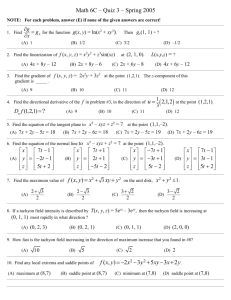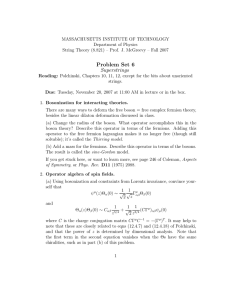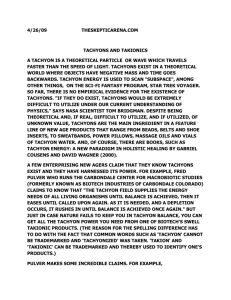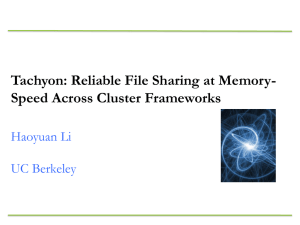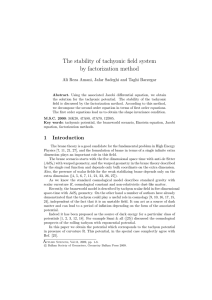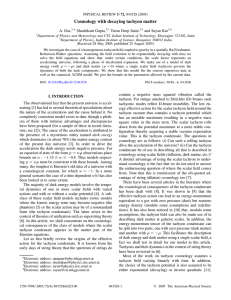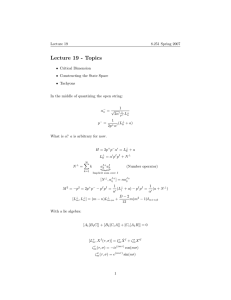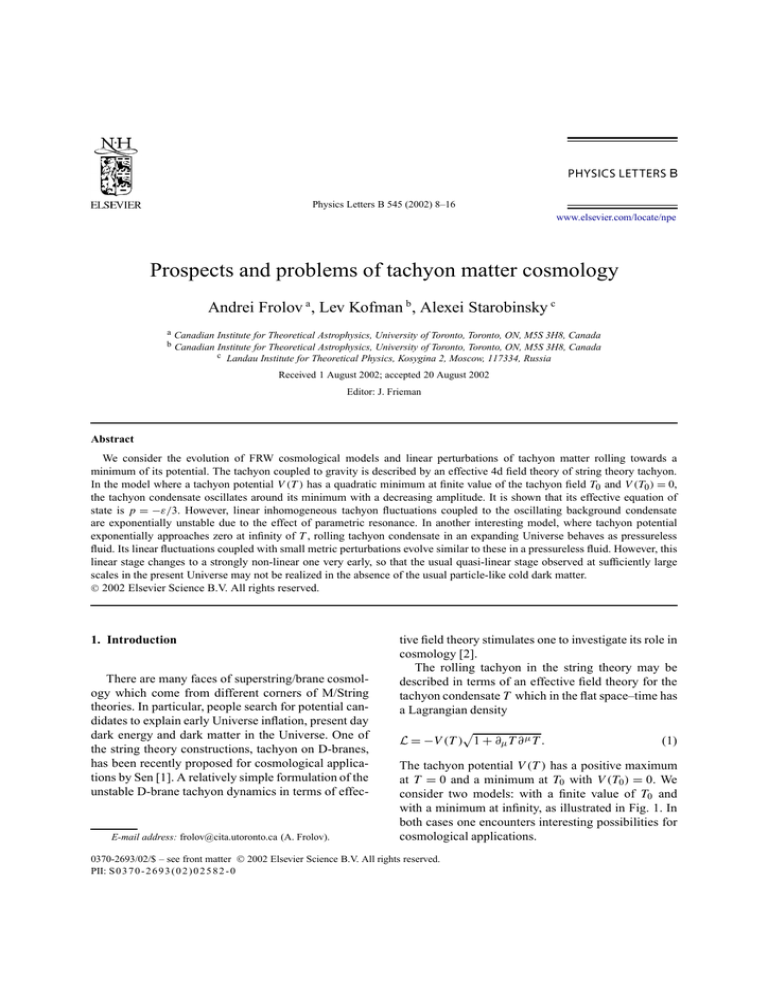
Physics Letters B 545 (2002) 8–16
www.elsevier.com/locate/npe
Prospects and problems of tachyon matter cosmology
Andrei Frolov a , Lev Kofman b , Alexei Starobinsky c
a Canadian Institute for Theoretical Astrophysics, University of Toronto, Toronto, ON, M5S 3H8, Canada
b Canadian Institute for Theoretical Astrophysics, University of Toronto, Toronto, ON, M5S 3H8, Canada
c Landau Institute for Theoretical Physics, Kosygina 2, Moscow, 117334, Russia
Received 1 August 2002; accepted 20 August 2002
Editor: J. Frieman
Abstract
We consider the evolution of FRW cosmological models and linear perturbations of tachyon matter rolling towards a
minimum of its potential. The tachyon coupled to gravity is described by an effective 4d field theory of string theory tachyon.
In the model where a tachyon potential V (T ) has a quadratic minimum at finite value of the tachyon field T0 and V (T0 ) = 0,
the tachyon condensate oscillates around its minimum with a decreasing amplitude. It is shown that its effective equation of
state is p = −ε/3. However, linear inhomogeneous tachyon fluctuations coupled to the oscillating background condensate
are exponentially unstable due to the effect of parametric resonance. In another interesting model, where tachyon potential
exponentially approaches zero at infinity of T , rolling tachyon condensate in an expanding Universe behaves as pressureless
fluid. Its linear fluctuations coupled with small metric perturbations evolve similar to these in a pressureless fluid. However, this
linear stage changes to a strongly non-linear one very early, so that the usual quasi-linear stage observed at sufficiently large
scales in the present Universe may not be realized in the absence of the usual particle-like cold dark matter.
2002 Elsevier Science B.V. All rights reserved.
1. Introduction
There are many faces of superstring/brane cosmology which come from different corners of M/String
theories. In particular, people search for potential candidates to explain early Universe inflation, present day
dark energy and dark matter in the Universe. One of
the string theory constructions, tachyon on D-branes,
has been recently proposed for cosmological applications by Sen [1]. A relatively simple formulation of the
unstable D-brane tachyon dynamics in terms of effec-
E-mail address: frolov@cita.utoronto.ca (A. Frolov).
tive field theory stimulates one to investigate its role in
cosmology [2].
The rolling tachyon in the string theory may be
described in terms of an effective field theory for the
tachyon condensate T which in the flat space–time has
a Lagrangian density
L = −V (T ) 1 + ∂µ T ∂ µ T .
(1)
The tachyon potential V (T ) has a positive maximum
at T = 0 and a minimum at T0 with V (T0 ) = 0. We
consider two models: with a finite value of T0 and
with a minimum at infinity, as illustrated in Fig. 1. In
both cases one encounters interesting possibilities for
cosmological applications.
0370-2693/02/$ – see front matter 2002 Elsevier Science B.V. All rights reserved.
PII: S 0 3 7 0 - 2 6 9 3 ( 0 2 ) 0 2 5 8 2 - 0
A. Frolov et al. / Physics Letters B 545 (2002) 8–16
(a)
9
(b)
Fig. 1. Tachyon matter potentials with a minimum at a finite (a) and the infinite (b) value of the field. The potentials near the minimum are taken
to be: (a) V (T ) = 12 m2 (T − T0 )2 , (b) V (T ) = V0 e−T /T0 .
In the case of finite T0 , we consider quadratic expansion around the minimum of the potential V (T ) ≈
1 2
2
2 m (T − T0 ) . As we will show, in this case the
tachyon matter has negative pressure and may be considered a candidate for quintessence.
In the case when T0 → ∞, we use exponential asymptotic of the potential V (T ) = V0 e−T /T0 derived
from the string theory calculations [3–5] (the exact
form of the potential from Ref. [3,4] is V = (1 +
T
−T /T0 ; our qualitative results for late time asympT0 )e
totics of T (t) do not depend on the pre-exponential
factor). Dimensional parameters of the potential are
related to the fundamental length scale, T0 ∼ ls , and
V0 is the brane tension. As it was demonstrated by
Sen [5], the tachyon matter is pressureless for the potential with the ground state at infinity. In this case
tachyon matter may be considered a cold dark matter
candidate [1].
It is noteworthy that models of type (1) have already been studied in cosmology on phenomenological grounds. For certain choices of potentials V and
non-minimal kinetic terms one can get kinematically
driven inflation, “k-inflation” [6]. In particular, a toy
model with the potential V (T ) ∼ 1/T 2 with a ground
state at infinity may give rise to the power law inflation of the Universe [6–8]. However, it remains to
be seen how this potential can be motivated by the
string theory of tachyon. The model with V ≡ const
is reduced to the so-called “Chaplygin gas” where the
matter equation of state is p = −const/ε. Such matter was suggested as a candidate for the present dark
energy [9,10].
In this Letter, we investigate cosmology with
tachyon matter with the string theory motivated potentials of Fig. 1. In Section 2, we write down
equations for the tachyon matter coupled to gravity. We focus on self-consistent formulation of the
isotropic Friedmann–Robertson–Walker (FRW) cosmology supported by the tachyon matter. It is described by coupled equations for the time-dependent
background tachyon field T (t) and the scale factor of
the Universe a(t).
One of the lessons of the scalar field theory in
cosmology is the possibility of the fast growth of
inhomogeneous scalar field fluctuations, as it was
found in different situations. Instability of scalar field
fluctuations are typical for preheating after inflation
due to the parametric resonance [11], or tachyonic
preheating after hybrid inflation [12] (which so far has
only remote relation with the string theory tachyon).
Fluctuations may be unstable in axion cosmology due
to parametric resonance [13]. Therefore, we address
the problem of stability of linear fluctuations of the
rolling tachyon matter.
Consistent investigation of tachyon cosmology, in
principle, should be started with the tachyon rolling
from the top of its potential which has negative curvature. In this case the setting of the problem is similar to what we met in tachyonic preheating after
hybrid inflation [12]. In these cases we expect fast
decay of the scalar field into long-wavelength inhomogeneities. Here we assume that the somehow homogeneous tachyon rolls towards the minimum of its
potential as the Universe expands, and consider
10
A. Frolov et al. / Physics Letters B 545 (2002) 8–16
tachyon fluctuations at the latest stages of its evolution.
In Section 3, we develop a formalism for treating
small fluctuations of the tachyon field δT (t, x). It is
possible to extend the theory of tachyon matter fluctuations by including scalar metric fluctuations. This
allows us to address the issue of gravitational instability in tachyon cosmology. Applying this analysis for
specific tachyon potentials, we will see that instability
of tachyon fluctuations is essential for the whole story
of tachyon cosmology.
In Section 4, we consider background cosmological
solutions for the tachyon potential with the ground
state at finite value T0 . We find that tachyon field is
oscillating around the minimum of its potential, while
its equation of state (averaged over oscillations) is
p = − 13 ε. Then in Section 5, we check the stability of
tachyon fluctuations around this background solutions,
and find that they are exponentially unstable due to the
parametric resonance.
In Section 6, we repeat the analysis for the model
where tachyon potential is exponential V (T ) ∝ e−T /T0
and its ground state is at T → ∞. In this case, background cosmological solution corresponds to the pressureless tachyon with energy density ε ∝ 1/a 3 . In Section 7, we consider small inhomogeneous tachyon and
metric fluctuations, and find gravitational instability of
fluctuations around the background solution. Specifically, we find that the linear approximation for fluctuations becomes insufficient very early for the pressureless rolling tachyon. We argue that the rolling tachyon
dark matter scenario may have difficulties in explaining gravitational clustering and large scale velocity
flows in the Universe.
generalized with respect to the metric gµν , ∂µ → ∇µ .
We use the metric with signature (−, +, +, +). The
model is given by the action
√
S = d 4 x −g
R
µ
− V (T ) 1 + ∇µ T ∇ T .
×
(2)
16πG
The Einstein equations which follow from (2) are
1
Rµν − gµν R
2 V
∇µ T ∇ν T
= 8πG √
1 + ∇α T ∇ α T
α
− gµν V 1 + ∇α T ∇ T ,
(3)
and the field equation for the tachyon is
∇µ ∇ µ T −
= 0.
∇µ ∇ν T
V,T
∇ µT ∇ ν T −
α
1 + ∇α T ∇ T
V
(4)
Let us apply these equations to a spatially flat (K = 0)
FRW cosmological model
ds 2 = −dt 2 + a 2 (t) d x 2.
(5)
For this geometry, the energy–momentum tensor of
tachyon matter in the right-hand side of Eq. (3) is
µ
reduced to a diagonal form Tν = diag(−ε, p, p, p)
where the energy density ε is positive
V (T )
ε= 1 − Ṫ 2
and the pressure p is negative or zero
p = −V (T ) 1 − Ṫ 2 .
(6)
(7)
2. Cosmology with rolling tachyon matter
Equation for the evolution of the scale factor follows
from (3)
A rolling tachyon is associated with unstable
D-branes, and self-consistent inclusion of gravity may
require higher-dimensional Einstein equations with
branes. Still, in the low energy limit, one expects that
the brane gravity is reduced to the four-dimensional
Einstein theory [14].
In this section, we consider tachyon matter coupled with Einstein gravity in four dimensions. Tachyon
matter is described by the phenomenological Lagrangian density (1), where derivatives are covariantly
ȧ 2 8πG V (T )
=
.
(8)
a2
3
1 − Ṫ 2
Equation for the time-dependent rolling tachyon in an
expanding Universe follows from (4)
V,T
T̈
ȧ
= 0.
(9)
+ 3 Ṫ +
2
a
V
1 − Ṫ
Note that the tachyon potential enters the field equation in a combination (ln V ),T .
A. Frolov et al. / Physics Letters B 545 (2002) 8–16
In the following sections we consider background
solutions of Eqs. (8) and (9) for two models of the
tachyon potentials V (T ) from Fig. 1.
3. Fluctuations in rolling tachyon
The issue of stability of a FRW background with
respect to small spatially inhomogeneous fluctuations
is often essential in cosmology. In this section, we
provide a formalism for treating linear inhomogeneous scalar fluctuations in tachyon cosmology. Let
us consider small inhomogeneous perturbation of the
tachyon field δT (t, x) around time-dependent background solution T (t) of Eq. (9):
T t, x = T (t) + δT t, x .
(10)
As we will see, for one of our examples of tachyon
potentials V (T ), instability of tachyon fluctuations
grows and becomes non-linear very quickly. Therefore, first we write down the equation for fluctuations
δT (t, x) ignoring expansion of the Universe and ignoring coupling of tachyon fluctuations to metric fluctuations.
Linearizing the field equation (4) (without the Hubble friction term) with respect to small fluctuations
δT and performing Fourier decomposition δT (t, x) =
3
d k Tk (t)ei k x of the linear fluctuations, we obtain
evolution equation for the time-dependent Fourier amplitudes Tk (t)
T̈k
2Ṫ T̈
Ṫk + k 2 + (log V ),T T Tk
+
2
2
2
1 − Ṫ
(1 − Ṫ )
= 0.
(11)
Next we consider tachyon fluctuations coupled with
metric perturbations in an expanding Universe. Small
scalar metric perturbations around a FRW background
can be written in the longitudinal gauge as
ds = −(1 + 2Φ) dt + (1 − 2Ψ )a (t) d x .
2
2
2
2
(12)
Now we have to linearize the Einstein equations (3)
and the field equation (4) with respect to small
fluctuations δT , Φ and Ψ . Then it follows that Φ =
Ψ for tachyon cosmology (as well as in many other
cases, in particular, for minimally coupled scalar field
cosmology).
11
Fortunately, the useful formalism for cosmological
scalar fluctuations for the class of models which
includes the theory (2) was developed in Ref. [6] (in
connection with “k-inflation”). This is exactly what we
need to pursue the investigation of small cosmological
fluctuations with tachyon matter. Using results of [6],
from (3) and (4) we obtain two coupled equations
for the time-dependent Fourier amplitudes Tk (t) and
Φk (t),
. 1 k 2 (1 − Ṫ 2 )3/2
Tk
= 1−
Φk ,
(13)
4πG a 2
V Ṫ 2
Ṫ
and
(aΦk ).
Tk
V Ṫ 2
= 4πG
.
2
1/2
a
(1 − Ṫ )
Ṫ
(14)
Introducing the Mukhanov variable vk , which is related to the potential Φk as
5ε + 3p
vk
2 ε Φ̇k
=
Φk +
,
z
3(ε + p)
3ε+p H
(15)
where energy density ε and pressure p are given by
Eqs. (6) and (7), H = ȧ/a, and
√
3 a Ṫ
,
z=
(16)
(1 − Ṫ 2 )1/2
Eqs. (13) and (14) can be reduced to a single second
order equation for vk
z
2 2
vk + 1 − Ṫ k −
(17)
vk = 0,
z
where prime ( ) stands for derivative with respect to
the conformal time dη = dt/a(t). We will use this
equation for analysis of coupled tachyon and metric
fluctuations in an expanding Universe in Section 7.
4. Negative-pressure tachyon matter
In this section, we consider the model with a
potential V (T ) with its ground state at a finite value
T0 , as it is sketched in the left panel of Fig. 1. Let us
assume that tachyon is rolling towards the minimum of
the potential T0 . We will approximate the shape of the
tachyon potential around the minimum by a quadratic
form V (T ) ≈ 12 m2 (T − T0 )2 . Despite quadratic form
of the potential, tachyon motion around T0 is not
harmonic, since ln V but not V is involved in the
12
A. Frolov et al. / Physics Letters B 545 (2002) 8–16
(a)
(b)
Fig. 2. (a) Background tachyon oscillations in the model with V (T ) = 12 m2 (T − T0 )2 . (b) Background oscillations of the tachyon equation of
state. The horizontal line p/ε = −1/3 is the time-averaged equation of state.
tachyon equation of motion. For the same reason
parameter m drops out of the field equation (9). It
is convenient to use tachyon field in units of T0 and
time t also in units of T0 . Parameter m, however, is
involved in the energy density of tachyon ε ∝ m2 /t 2 .
The choice of m ∼ ls−1 ∼ Mp may bring the value of ε
to the required density of dark energy.
Numerical solution of Eqs. (9) and (8) reveals that
the tachyon begins to oscillate around the minimum
of the potential very soon, within a time interval of
several T0 , as shown in the left panel of Fig. 2. The
amplitude of the oscillations is decreasing with time
due to the Hubble friction term in Eq. (9). The envelope curve (dashed line) in the left panel of Fig. 2
shows the amplitude decreasing as 1/t. As we will see
below, this time-dependence of the amplitude exactly
corresponds to the (time-averaged) equation of state
p/ε which will be found for the tachyon matter in this
model. Also, note that the period of oscillations is decreasing with time. Tachyon oscillations in this model
are not only non-harmonic, but also non-periodic.
The instant value of the ratio of energy density (6)
and pressure (7), p/ε = Ṫ 2 − 1, is oscillating with
time, as shown in the right panel of Fig. 2. Although
the amplitude of oscillations T is decreasing with
time, the amplitude of Ṫ is not changing with time as
it is clear from the Fig. 2.
The period of oscillations is very small (∼T0 ), so
that only the average equation of state is important for
cosmological evolution. To find it, we average Ṫ 2 − 1
over several consecutive oscillations. The average
value of p/ε, shown as the horizontal line at the right
panel of Fig. 2, is independent of time and equal to
1
p
=− .
ε
3
(18)
For this type of an equation of state, an average value
of the energy density is diluted as ε ∝ a −2 with
the expansion of the Universe. The amplitude of the
tachyon oscillations is then decreasing as 1/t, which
is compatible with numerical results. From (8) we find
that the averaged scale factor is a(t) ∝ t. Note that
equation of state similar to (18) occurs for a network
of cosmic strings.
The equation of state (18) for the quadratic tachyon
potential can be easily derived analytically. Indeed, assuming that tachyon is oscillating much faster than
the Universe expands, we can treat energy density ε
as adiabatic invariant, and write Ṫ 2 = 1 − V 2 (T )/ε2 ,
where ε is constant over several consecutive oscillations. Then the average value of Ṫ 2 for quadratic potential is
2
2
Ṫ dt
Ṫ = dt
(1 − V 2 (T )/ε2 )1/2dT
2
= .
=
(19)
(1 − V 2 (T )/ε2 )−1/2 dT
3
A. Frolov et al. / Physics Letters B 545 (2002) 8–16
So, p/ε = Ṫ 2 −1 = −1/3. If shape of the potential
around the minimum is not quadratic, but a powerlaw V ∝ (T − T0 )n , the average equation of state is
1
.
p/ε = − n+1
Although tachyon matter in the model has negative
pressure, apparently it is short of explaining the
present acceleration of the Universe. Combination of
cosmological observations of CMB fluctuations, large
scale structure clustering and high red shift supernovae
constrains the equation of state to be lower than
p/ε < −0.6 [16] (or even p/ε < −0.76 at 95%
c.l. according to [17]).
As we will see in the next section, background
tachyon dynamics in this model is unstable with
respect to small spatially inhomogeneous fluctuations,
and homogeneous tachyon oscillations will decay.
It will be interesting to find what will be the final
configuration of tachyon matter in this model and what
may be its potential application to cosmology.
5. Fluctuations in tachyon matter with negative
pressure
In a realistic cosmological scenario, it is expected
that the tachyon field has small, quantum or classical,
inhomogeneous fluctuations. In this section, we check
the stability of tachyon fluctuations around the background solution discussed in the previous section. For
the moment, let us ignore the expansion of the Universe. Then we only have to solve equation (11) to find
behaviour of fluctuations. Although formally some of
the coefficients in Eq. (11) are singular when the background field T (t) crosses zero in the case of quadratic
potential, it is possible to switch to regular variables
and overcome this technical inconvenience. Numerical solution of the fluctuation equation (for example,
for k = 10 in units of T0 ) is shown in Fig. 3.
General theory of linear equations with periodic
coefficients predicts the presence of stability and
instability bands of momenta k. For unstable modes,
the amplitude is increasing exponentially as Tk (t) ∼
eµk t . For the value of k in Fig. 3 the amplitude
of fluctuations is increasing with time exponentially
fast, by an order of magnitude in one background
oscillation, say Tk (t) increases by a factor of 1010 in
ten oscillations! The physical reason is amplification
due to the parametric resonance. This can be clearly
13
Fig. 3. Instability of fluctuations Tk (t) in the model with the
quadratic potential (scales are linear).
seen if one rewrites equation (11) in the form of the
oscillator-like equation, where the effective frequency
is oscillating with time. This effect can be described
by the theory of broad parametric resonance [15].
Since period of oscillation (∼T0 ) is tiny compared
to the cosmological time, and fluctuations become
significant within several background oscillations, one
can ignore expansion of the Universe in this analysis.
Thus we conclude that, in the model with the quadratic
potential, small tachyon fluctuations are exponentially
unstable and a background tachyon condensate decays
into a strongly inhomogeneous field configuration.
Decay of the background tachyon condensate into
inhomogeneous fluctuations does not necessarily mean
that the Universe becomes inhomogeneous. The
tachyon fluid remains homogeneous as a whole, but
not as a coherent condensate. Therefore, it remains
to be seen, based on the fully non-linear analysis,
what will be equation of state of the non-condensate
tachyon fluid.
6. Pressureless tachyon matter
In this section, we consider tachyon cosmology for
a tachyon potential having its ground state at infinity
and decaying sufficiently fast:
T 2 V (T ) → 0,
T → ∞,
(20)
as sketched in the right panel of Fig. 1 for a particular
example of exponential potential. Background cosmological solutions of Eqs. (8) and (9) for this case very
quickly (several T0 ) enter the regime where tachyon is
rolling very fast and Ṫ approaches unity. Let us write
14
A. Frolov et al. / Physics Letters B 545 (2002) 8–16
T (t) = t + θ (t), |θ | t (note that θ̇ < 0). To the first
order in θ , Eq. (9) reduces to
V
ȧ
θ̈
= 6 + 2 (21)
a
V T =t
θ̇
which can be easily integrated. We obtain:
1 a 6 V 2 θ̇ = −
,
2 a0 V02 T =t
1 − Ṫ 2 = −2θ̇,
ε = V0
|p| ε.
a0
a
a0 , V0 = const,
3
,
p=−
a
a0
3
(22)
V 2 ,
V0 T =t
(23)
Thus, for a wide class of potentials (20) the tachyon
at late times behaves as a dust-like matter, as was first
discovered by Sen [1,5] in flat space–time. We see that
inclusion of gravity leads to the scaling of the tachyon
energy density with the scale factor: ε ∝ a −3 , which is
just the right one for a cold dark matter. This makes
tachyon matter with such potentials a cosmological
dark matter (not dark energy!) candidate. Note that
formulas (22) and (23) apply, in particular,√both for
the radiation dominated stage where a(t) ∝ t where
tachyon contribution to gravity is subdominant, and
for a(t) ∝ t 2/3 where tachyon gravitationally dominates.
In case of the exponentially decaying potential V =
V0 e−T /T0 , Eq. (22) leads to
T0 a 6 −2t /T0
T (t) = t +
(24)
e
,
4 a0
and then pressure vanishes with time exponentially
fast. Without expansion of the Universe, the solution (24) corresponds to that of Sen [18].
7. Cosmological fluctuations for pressureless
tachyon
The crucial property of cosmological dark matter
without pressure is the growth of cosmological fluctuations which form a developed large scale structure.
The large scale structure of the Universe is ranging
from non-linear clustered halos of galaxies and clusters of galaxies, quasi-linear structures at scales of superclusters and voids, and linear fluctuations at very
large scales. It is essential that at quasi-linear and nonlinear stages dark matter is displaced from the homogeneous distribution due to flows generated by fluctuations of gravitational potential, and gravitationally
bound halos have high velocity dispersions.
In this section, we investigate clustering properties
of the pressureless tachyon matter. We assume rolling
tachyon matter domination, so that the law of the
Universe expansion is a(t) ∝ t 2/3 .
We begin with the linear analysis of cosmological fluctuations, using formalism of Section 3. For a
moment, consider the case without expansion of the
Universe and without coupling to gravitational perturbations. Then it follows from Eq. (11) for the exponential potential that fluctuations are not growing,
Tk = const.
Now let us consider tachyon fluctuations including
expansion of the Universe and coupling to a gravitational potential Φ. Substituting the background solution (24) for the pressureless tachyon matter into
Eq. (17), one can see that the coefficient in front
of k 2 (which plays the role of the sound speed for
the tachyon matter) vanishes exponentially fast. This
means that the growth of linear tachyon fluctuations
is scale independent, similar to that of the standard
cold dark matter scenario. Then the solution of (17) is
vk = z, and the left-hand side of Eq. (15) is constant.
From this we immediately get the time evolution of
fluctuations Φk and Tk
Φk (t) = const,
Tk (t) = Φk · t.
(25)
Linear metric fluctuations are constant, similar to that
in the cold dark matter scenario. However, the fluctuations in the tachyon field are growing, in contrast to the simplified analysis above where we
neglected coupling to the metric fluctuations and expansion of the Universe. The growth of tachyon fluctuations Tk ∝ t cannot be obtained without these ingredients. Thus, tachyon fluctuations are unstable due
to the effects of gravitational instability in an expanding Universe.
However, a linear approximation for the rolling
tachyon/gravity system works only during a very short
time interval (of the order of tens of T0 ). Indeed, let
us inspect the energy density of tachyon matter in the
model with the exponential potential not assuming it to
be homogeneous and using the perturbed space–time
A. Frolov et al. / Physics Letters B 545 (2002) 8–16
metric (12):
ε= V0 e−T /T0
1 − (1 − 2Φ)Ṫ 2 + a −2 (∇x T )2
.
(26)
For fluctuations of δT , we have δT Φ(
x )t where
Φ(
x ) describes the initial spatial profile of fluctuations. The full tachyon field including fluctuations is
T t, x
= t + (T0 /4)(a/a0)6 e−2t /T0 + Φ x t.
(27)
The numerator of the expression (26) vanishes as
e−t /T0 , while the denominator evolves as (a/a0)6 ×
e−2t /T0 + a −2 t 2 (∇x Φ)2 . The linear approximation
works during a very short time interval while (∇x Φ)2 e−2t /T0 . When this inequality breaks, linear analysis
becomes insufficient. For cosmological fluctuations
Φ ∼ 10−5 , the linear theory for δT is valid during a
time interval of order of 10T0 . Recall that for the standard cold dark matter scenario the linear stage lasts
during a significant fraction of the present age of the
Universe.
8. Summary
We considered cosmological solutions of rolling
tachyon condensate T for two models of tachyon
potential V (T ). There are different levels at which one
can theoreticize about T (t) in an expanding Universe.
Systematic approach suggests for us to begin with a
theory of tachyon field rolling down from the top of its
potential. The curvature of the potential at the origin is
negative, and we expect tachyonic instability of long
wavelength fluctuations, similar to spinodal instability
in usual field theory [12]. Thus there is an issue of
initial conditions for rolling tachyon cosmology.
Suppose (by choice of initial conditions where T
is displaced from the origin) tachyon evolves towards
its ground state as a homogeneous condensate. We
considered the model with minimum at finite T0 and
with quadratic approximation of V (T ) around the
minimum. Then the background tachyon oscillates
around the minimum with frequency of order of
1/T0 , and its (averaged over several oscillations)
equation of state is p/ε = −1/3. However, we found
from perturbation theory that tachyon fluctuations
15
are exponentially unstable due to the tachyon selfinteraction with background oscillations. It means
that in this model homogeneous tachyon condensate
decays. To answer the question what will be the
resulting tachyon configuration, one has to go to
the next level beyond the perturbation theory and to
consider fully non-linear problem of evolution of noncondensate tachyon fluid.
We also consider homogeneous tachyon rolling towards its ground state in the model with V (T ) ∝
e−T /T0 , including expansion of the Universe. In this
model, the background tachyon condensate has vanishing pressure and finite energy density diluting as
ε ∝ 1/a 3 . Considering linear perturbations of tachyon
field coupled with small metric perturbations, we
found gravitational instability of tachyon field, δT ∝ t.
However, linear theory very soon (tens of T0 ) becomes
irrelevant. Clearly, much more work including a full
non-linear analysis is needed to make more certain
conclusions about viability of tachyon cosmology.
Acknowledgements
We are grateful to D. Bond and A. Linde for useful
comments. We thank NATO Linkage Grant 975389
for support. A.F. was supported by NSERC, L.K. was
supported by NSERC and CIAR. The work of A.S.
in Russia was partially supported by RFBR, grants
Nos. 02-02-16817 and 00-15-96699, and by the RAS
Research Program “Astronomy”. A.S. thanks CITA
for hospitality during his visit.
References
[1] A. Sen, hep-th/0203265.
[2] G.W. Gibbons, Phys. Lett. B 537 (2002) 1, hep-th/0204008.
[3] A.A. Gerasimov, S.L. Shatashvili, JHEP 0010 (2000) 034, hepth/0009103.
[4] D. Kutasov, M. Marino, G.W. Moore, JHEP 0010 (2000) 045,
hep-th/0009148.
[5] A. Sen, JHEP 0204 (2002) 048, hep-th/0203211.
[6] C. Armendáriz-Picón, T. Damour, V. Mukhanov, Phys. Lett.
B 458 (1999) 209, hep-th/9904075.
[7] J. Garriga, V.F. Mukhanov, Phys. Lett. B 458 (1999) 219, hepth/9904176.
[8] A. Feinstein, hep-th/0204140.
[9] A.Y. Kamenshchik, U. Moschella, V. Pasquier, Phys. Lett.
B 511 (2001) 265, gr-qc/0103004.
16
A. Frolov et al. / Physics Letters B 545 (2002) 8–16
[10] J.C. Fabris, S.V.B. Gonçalves, P.E. de Souza, astroph/0203441.
[11] L. Kofman, A.D. Linde, A.A. Starobinsky, Phys. Rev. Lett. 73
(1994) 3195, hep-th/9405187.
[12] G.N. Felder, J. Garcia-Bellido, P.B. Greene, L. Kofman, A.D.
Linde, I. Tkachev, Phys. Rev. Lett. 87 (2001) 011601, hepph/0012142.
[13] P.B. Greene, L. Kofman, A.A. Starobinsky, Nucl. Phys. B 543
(1999) 423, hep-ph/9808477.
[14] S. Mukohyama, Phys. Rev. D 66 (2002) 024009, hepth/0204084.
[15] L. Kofman, A.D. Linde, A.A. Starobinsky, Phys. Rev. D 56
(1997) 3258, hep-ph/9704452.
[16] J.R. Bond, D. Pogosyan, S. Prunet, K. Sigurdson, MaxiBoom
Collaboration, in: Proc. CAPP-2000 (AIP), CITA-2000-64,
astro-ph/0011379.
[17] R. Bean, A. Melchiorri, Phys. Rev. D 65 (2002) 041302, astroph/0110472.
[18] A. Sen, hep-th/0204143.

